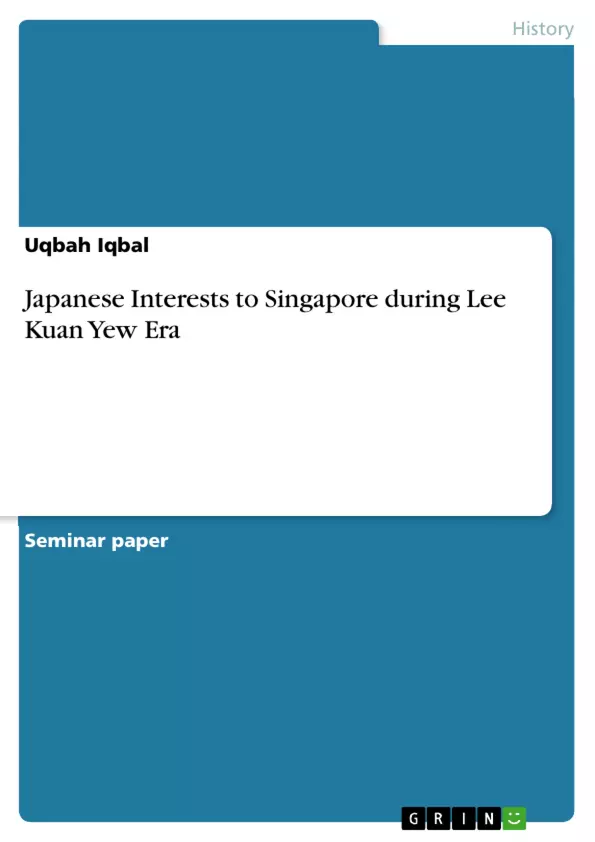On 17 June 1973, the new Singapore ambassador to Japan, Wee Mon Cheng expressed his hope to encourage the Japanese people to invest and divert their modern technology to Singapore. He will also encourage the Japanese people to buy light company goods made in Singapore. In January 1975, Singapore's ambassador to Japan, Cheng Wee Moon described the year 1975 as an important year for Japanese investors to invest in Singapore. The worldwide economic downturn brings new opportunities for the development and restructuring of companies in Singapore. With that the Japanese businessmen and companies should take this opportunity to develop together a strong company for mutual benefits. They should be prepared to feel the benefit when world economic activity and opportunities in the Southeast Asian region live again. The world market scenario has caused many workers in Singapore discharged from factories that use a lot of labor, such as electronics, timber and garments which takes half of Singapore's labor force. Because they are young, they have become a useful source of labor and can be trained by new factories.
Inhaltsverzeichnis (Table of Contents)
- Japanese Interests to Singapore during Lee Kuan Yew Era
- Leadership characteristics
- Singapore's Ambassador to Japan
- Japanese Investment in Singapore
- Economic Development Board (EDB)
- Singapore's Economic Growth
- Japanese Companies in Singapore
- Local Companies Improvement Plan (LCIP)
Zielsetzung und Themenschwerpunkte (Objectives and Key Themes)
This text examines the close economic relationship between Singapore and Japan during the Lee Kuan Yew era. It explores how Singapore sought to emulate Japan's economic success and leverage Japanese investment to accelerate its own industrialization process.
- Singapore's economic development strategy
- The role of Japanese investment in Singapore's growth
- The impact of Japanese culture and management practices on Singapore
- The strategic importance of Southeast Asia to Japan's economic interests
- The challenges and opportunities of economic cooperation between Singapore and Japan
Zusammenfassung der Kapitel (Chapter Summaries)
- The text begins by highlighting Singapore's admiration for Japan's economic achievements and Lee Kuan Yew's vision of "Learning from Japan" to accelerate Singapore's industrialization.
- It then explores the key leadership characteristics that enabled Japan's economic rise and the close ties between Lee Kuan Yew and Japan, evident in his frequent visits to the country.
- The text focuses on the role of Singapore's ambassador to Japan, Wee Moon Cheng, in promoting Japanese investment and technology transfer to Singapore.
- It details the growth of Japanese investment in Singapore throughout the 1970s and 1980s, highlighting the benefits for both countries.
- The text describes the Singapore Economic Development Board's (EDB) efforts to attract Japanese multinational companies and facilitate the transfer of Japanese management practices and technology to Singapore.
- It examines the broader economic context of Singapore's growth, emphasizing the importance of Japanese investment in the context of global economic shifts.
- The text highlights the efforts of the Singapore government to encourage Japanese companies to expand their operations in Singapore, including the establishment of research and development centers.
- It discusses the importance of the Local Companies Improvement Plan (LCIP) in fostering collaboration between Japanese and local companies, aiming to improve productivity and competitiveness.
Schlüsselwörter (Keywords)
The main keywords and focus topics of this text include Japanese investment, economic development, industrialization, technology transfer, cultural exchange, Singapore-Japan relations, Lee Kuan Yew, Wee Moon Cheng, Economic Development Board (EDB), Local Companies Improvement Plan (LCIP), and Southeast Asia.
- Citation du texte
- Uqbah Iqbal (Auteur), 2015, Japanese Interests to Singapore during Lee Kuan Yew Era, Munich, GRIN Verlag, https://www.grin.com/document/302852



